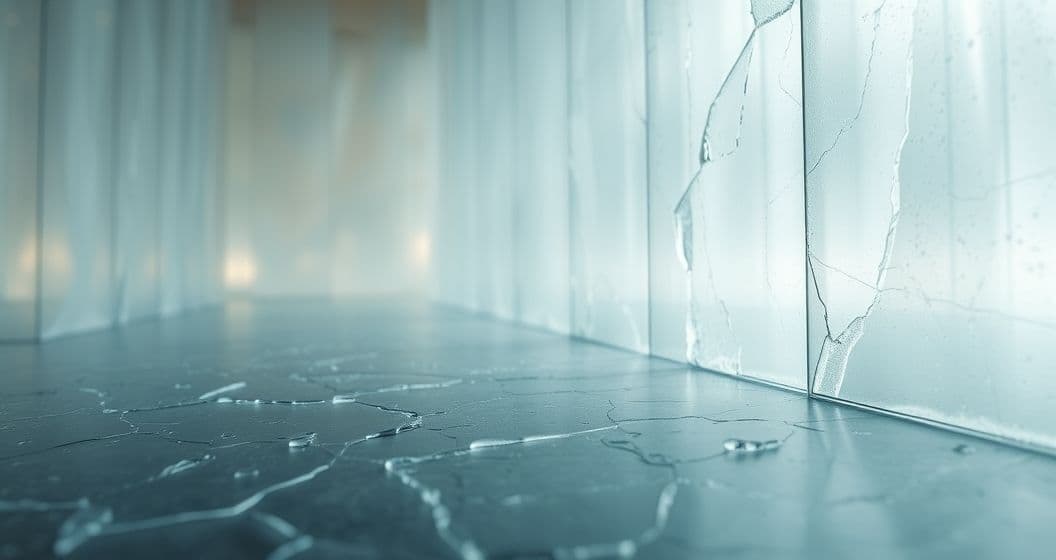Core Symbols: The Fragility of Paths and Chambers
Dreams of broken glass footprints and glass chambers are rich with symbolic tension, blending physical fragility with emotional depth. Broken glass, in dreamwork, rarely signifies mere destruction—it often represents clarity emerging from chaos, or the shattering of illusions to reveal deeper truths. The act of following footprints adds movement and intention: these aren’t random shards but a deliberate trail, suggesting you’re actively navigating through something vulnerable. Glass chambers, meanwhile, evoke enclosed spaces of reflection or hidden knowledge—think of a crystal cave or a greenhouse, both protective and revealing. Together, the image paints a picture of walking through painstakingly collected emotional fragments toward a space that holds answers or transformation.
Consider a dreamer who steps on glass shards, each footprint leaving a glimmering trail behind. The glass isn’t just sharp; it’s translucent, catching light to show the path clearly. This dual nature mirrors life: even painful experiences (the glass) can illuminate your direction (the trail). The chambers themselves might feel both familiar and foreign—like a childhood bedroom transformed into a cathedral of glass, or a forgotten closet now holding your true desires. This duality hints at the subconscious’s ability to revisit old spaces with new insight.
Psychology Lens: From Jungian Archetypes to Emotional Processing
Want a More Personalized Interpretation?
Get your own AI-powered dream analysis tailored specifically to your dream
🔮Try Dream Analysis FreeTo unpack this dream, we turn to psychology’s crossroads of emotion and symbolism. Carl Jung might interpret the glass footprints as the shadow self—the parts of you you’ve avoided, now leaving a trail of awareness as you confront them. The glass’s transparency could reflect the shadow’s blurred edges, once hidden but now visible in your dream. Meanwhile, Sigmund Freud might see the shards as repressed emotions: anger, fear, or grief that have fractured your sense of safety, now demanding attention.
Neuroscience adds another layer: during REM sleep, the brain processes emotional memories, turning raw feelings into symbolic narratives. Broken glass dreams often spike when you’re in a period of emotional upheaval—like a breakup, job loss, or identity shift. The glass footprints could represent how your mind is literally walking through these emotions, step by step, while the chamber is the REM brain’s attempt to integrate these fragmented feelings into coherent self-knowledge. It’s as if your subconscious is building a new emotional architecture, one shard at a time.
Life Triggers: When the Subconscious Whispers Through Glass
These dreams rarely appear without context. If you’ve recently experienced loss—a relationship, a job, or even a sense of self—glass footprints might symbolize the 'stepping stones' of grief. The act of following them into a chamber could mean you’re ready to move from mourning to reflection, to process what’s been lost rather than letting it define you.
Career transitions often spark similar imagery. Imagine someone leaving a stable job for uncertainty: the glass footprints could represent the shaky ground of change, while the chamber is the new role or identity taking shape. The glass isn’t just breaking—it’s forming as you walk, suggesting that even uncertainty can be a creative process.
Identity shifts, too, trigger this symbolism. If you’re questioning who you are—whether due to age, new relationships, or life milestones—the glass footprints might be your subconscious testing boundaries: 'Can I handle the sharp edges of this new self?' The chamber then becomes the inner space where you experiment with this new identity, safe from external judgment.
What To Do Next: From Dream to Daily Life
Start by journaling the details of your dream. Note the glass’s texture (smooth or jagged?), the chamber’s lighting (dim or bright?), and how you felt (afraid, curious, numb?). These details reveal personal associations—for example, smooth glass might signal acceptance, while jagged glass could mean lingering fear.
Next, reflect on your current life. Are you avoiding a difficult conversation? Navigating a transition? The glass footprints might be urging you to follow that path, even if it’s uncomfortable. Try a small experiment: if the dream feels tied to a relationship, write a letter to the other person (even if unposted) to 'walk' through those emotions. This mirrors the dream’s journey from shards to chamber.
Long-term, embrace the metaphor of glass as both barrier and bridge. Instead of seeing brokenness as failure, view it as a new kind of strength—like glassblowing, where heat and pressure transform fragments into something beautiful. Practice mindfulness around your own 'glass' moments: when you feel fragile, ask, 'What chamber am I building?' This shifts perspective from pain to purpose.
FAQ: Navigating the Glass Dreamer’s Questions
Q: Why do I keep dreaming of following broken glass footprints?
A: This recurring dream suggests your subconscious is processing a significant life shift or emotional wound. The repetition invites you to engage with what’s being revealed, not just observe it.
Q: Are these dreams always negative?
A: No—they can signify clarity. Glass breaking often reveals hidden truths, and following the path shows courage to face vulnerability. Think of it as your mind saying, 'I’m ready to see what’s beneath the surface.'
Q: How do I tell if this is about a specific issue?
A: Notice the dream’s context: were the chambers familiar? Did the glass feel like protection or danger? These clues tie to current relationships, career, or self-perception.
